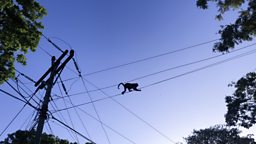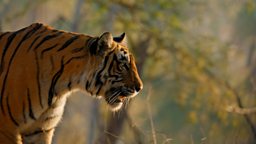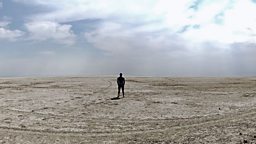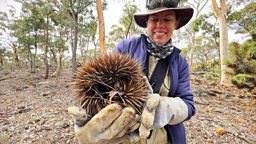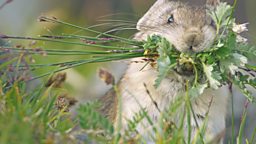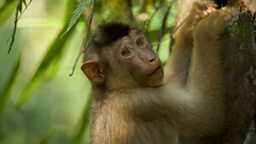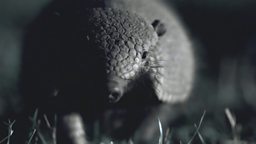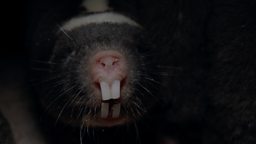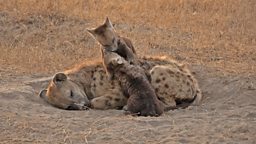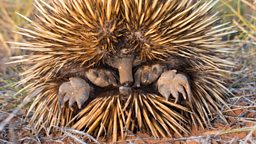Tiptoeing giants - Filming urban elephants
By Mammals Assistant Producer, Harriet Lawrence
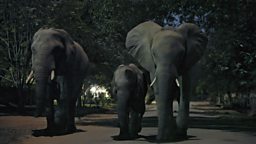
Imagine sitting silently in an open-sided truck, eyes transfixed on a herd of wild elephants passing only a few metres away under the moonlight. When one of them – the largest matriarch – turns to face you. Directly you. You lock eyes as your heart climbs up your throat. And then, slowly, she takes a step towards you. And another. All the hairs on your arms stand up and a wave of panic washes through you.
Her head fills the doorframe of the car.
Too scared to turn your head towards Max, the cameraman who’s pushed himself as far back into the truck bed as he can go. Too transfixed to take your eyes off her for even a moment. A tiny firm thought flickers through your mind – you must stay absolutely still and absolutely quiet. She’s within arm’s reach now, and you stop breathing. Her head fills the doorframe of the car. As if time has turned to jelly, she reaches out – and her trunk brushes your jacket, lightly tugging at your shoulder before floating up to hover right in front of your nose.
There’s no room for thoughts in your mind, there should maybe be terror, but there’s just total awe – and strangely, joy. You can feel her hot breath on your face. It smells sweet and earthy, like cut grass and cow farms. Hot puffs of air pass over your face, twice. And then it’s over.
Have you ever thought about the most surreal moment of your life? I think about this one often. I remember genuinely pinching myself after. My fingers were shaking.

When I was asked to direct this shoot, following the nightly jaunts of African elephants through Victoria Falls town, I was so excited. I’d dreamt of seeing elephants in the wild since I was a little girl. For my 8th birthday my parents took me to Dudley Zoo, and a keeper let me feed sliced white bread to their two elephants. They were colossal, and beautiful, and I was in love. Victoria Falls itself is one of the Wonders of the World – and it lived up to the hype. But it was the elephants that took my breath away.
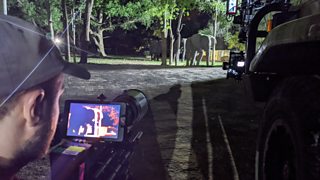
That first close encounter wasn’t the only time I had to pinch myself during my month in Victoria Falls. Words cannot do justice to how mind bending it is to watch a creature as colossal, as awe-inspiring and as wild as an African elephant walking past the houses of a residential street. Or expertly turning on a garden tap. Or silently “tiptoeing” past the lit windows of a family home, the flicker of the TV throwing blue light over an outstretched trunk. We held our breath as a family of elephants squeezed past us in an alleyway, the tiny baby letting out a fierce trumpet as if saying “This is my town!”. Close enough that I had to fight a sudden urge to reach out and touch it.
I remember the sound of their deep sighs, and the soft scuffs of their feet on the tarmacked roads. On one night the mother leant over a parked car to shake a pink tree in full blossom and the baby looked up as petals rained down on it from above. I think that time I cried. Every night felt as surreal as that “Pink Elephants On Parade” scene in Dumbo. Like at any moment these giants would stand on their hind legs and start playing the trumpet.
But for many people in Africa this is a pretty normal occurrence. Elephants and people share space all over the continent – and their interactions are not always so peaceful. It’s a difficult conundrum when towns and agriculture sprout up in an elephant’s old stomping grounds. Can you keep these intelligent giants out? And should you?
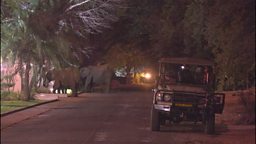
Here, the elephants have learnt to enter the town at night in order to avoid people, but the rising conflict can still lead to deadly interactions on both sides. Some locals said we were mad to go out after dark. Our guide told us people usually get hurt when they accidently surprise the elephants. At first, I thought this sounded strange – how could you not see an elephant? But after a few days cruising the empty streets I realised how seamlessly their grey bodies blend into the shadows, and how soundlessly they tread tarmacked roads. They move like seven-ton ninjas. On many nights we lost them completely, like they had turned a corner and just evaporated into the night. We resorted to using thermal scopes to spot elephants in dark alleyways and hidden amongst gardens. And on more than one occasion we had to warn unsuspecting pedestrians that a dark shadow ahead held a huge bull, or a nervous mother and her baby.
They move like seven-ton ninjas.
Like many places globally, the population of Africa is growing, but the space available to both people and wildlife is limited. Preserving wild spaces for elephants through the creation of National Parks and Reserves can help keep both safe, but in the Kaza Trans Frontier Conservation Area, the parks are unfenced – and the town of Victoria Falls lies in the heart of this.
Elephants naturally make long-distance movements in search of seasonal foods, and here this means they forage between the protected fragments of the parks and in human territories. Sharing space with wild animals is always challenging, but especially when they’re this powerful. The elephant-sized holes decorating the garden walls of Victoria Falls are proof.
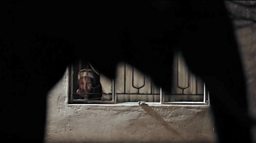
All over the world, communities and conservationists are trying to come up with solutions to human-elephant conflict. When elephants take crops from people, they are often taking their livelihood or food needed to feed their families. This can lead to retaliatory attacks on elephants, and fatal injuries for the people. Elephants are highly resourceful and resilient, capable of forcing their way through concrete walls and even expensive electric fences.
Some alternative solutions rely on utilising behavioural data to create natural deterrents. Elephants are scared of bees which sting inside their trunks and ears, so in some places farmers are surrounding their fields with fences made of linked beehives. Eventually the elephants learn to move away as soon as they hear the bees, and so researchers have also been trialling cheaper alternatives like audio deterrents of angry bee sounds to guide elephants away from human settlements. Some people cover wire fences in chilli – another thing elephants hate. Others set fire to chilli bombs, made of dried dung soaked in chilli, to create a spicy irritating smoke that drives the elephants away.
However, their incredible intelligence means that elephants are constantly testing the boundaries of new techniques and quickly learn from their peers. All these methods are showing promise, but they’re relatively expensive, time consuming and have varied effectiveness dependant on the situation. There’s no single, quick or easy solution for how to live alongside the Earth’s largest land mammals, but the ongoing research is vitally important if both elephants and people are going to thrive.


